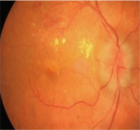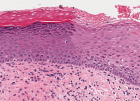Abstract
Research Article
Development of ELISA based detection system against C. botulinum type B
Arti Sharma* and S Ponmariappan
Published: 30 March, 2020 | Volume 3 - Issue 1 | Pages: 017-020
Botulism is the disease caused by botulinum neurotoxins. It is produced by an obligate anaerobic bacteria called Clostridium botulinum. There is no immuno-detection system available in the world for the detection of C. botulinum. Secretory proteins of cooked meat media grown C. botulinum type B were extracted by TCA precipitation method. Polyclonal antibodies were generated against secretory proteins. Cytokine profiling of secretory proteins were done. An immunodetection system was developed to detect the C. botulinum type B using Secretory proteins of C. botulinum type B.
Read Full Article HTML DOI: 10.29328/journal.ijcmbt.1001010 Cite this Article Read Full Article PDF
Keywords:
Anaerobic; Botulism; ELISA; Centrifugation; Antiserum
References
- Agarwal AK, Goel A, Kohli A, Rohtagi A, Kumar R. Food-borne botulism. J Assoc Physicians India. 2004; 52: 677-678. PubMed: https://www.ncbi.nlm.nih.gov/pubmed/15847370
- Chaudhry R, Dhawan VB, Kumar D, Bhatia R, Gandhi JC, et al. Outbreak of suspected Clostridium butyricum botulism in India. Emerg Infect Dis. 1998; 4: 506-507. PubMed: https://www.ncbi.nlm.nih.gov/pmc/articles/PMC2640317/
- Fillo S, Giordani F, Anselmo A, Fortunato A, Palozzi AM, et al. Draft genome sequence of Clostridium botulinum B2 450 strain from wound botulism in a drug user in Italy. Genome Announc. 2015; 3: e00238-15. PubMed: https://www.ncbi.nlm.nih.gov/pubmed/25838491
- de Jong LI, Fernández RA, Pareja V, Giaroli G, Guidarelli SR, et al. First report of an infant botulism case due to Clostridium botulinum type Af, J Clin Microbiol.2015; 53: 740-742. PubMed: https://www.ncbi.nlm.nih.gov/pubmed/25502535
- MacDonald E, Arnesen TM, Brantsaeter AB, Gerlyng P, Grepp M, et al. Outbreak of wound botulism in people who inject drugs, Norway, October to November 2013, Euro Surveill. 2013; 18: 20630. PubMed: https://www.ncbi.nlm.nih.gov/pubmed/24229788
- Hernández-de Mezerville M, Rojas-Solano M, Gutierrez-Mata A, Hernández-Con L, Ulloa-Gutierrez R et al. Infant botulism in Costa Rica: first report from Central America. J Infect Dev Ctries. 2014; 8: 123-125. PubMed: https://www.ncbi.nlm.nih.gov/pubmed/24423723
- Kautter DA, Solomon HM. Collaborative study of a method for the detection of Clostridium botulinum and its toxins in foods. J Assoc Off Anal Chem. 1977; 60: 541-545. PubMed: https://www.ncbi.nlm.nih.gov/pubmed/323214
- Cai S, Singh BR, Sharma S. Botulism diagnostics: from clinical symptoms to in vitro assays. Crit Rev Microbiol. 2007; 33: 109-125. PubMed: https://www.ncbi.nlm.nih.gov/pubmed/17558660
- Lindström M, Keto R, Markkula A, Nevas M, Hielm S, et al, Multiplex PCR assay for detection and identification of Clostridium botulinum types A, B, E, and F in food and fecal material. Appl Environ Microbiol. 2001; 67: 5694-5699. PubMed: https://www.ncbi.nlm.nih.gov/pubmed/11722924
- Sharma A, Ponmariappan S, Sarita R, Alam SI, Kamboj DV, et al. Identification of Cross Reactive Antigens of C. botulinum Types A, B, E & F by Immunoproteomic Approach. Curr Microbiol. 2018; 75: 531-540. PubMed: https://www.ncbi.nlm.nih.gov/pubmed/29332140
- Doellgast GJ, Beard GA, Bottoms JD, Cheng T, Roh BH, et al. Enzyme-linked immunosorbent assay-enzyme-linked coagulation assay for detection of antibodies to Clostridium botulinum neurotoxins A, B, and E and solution-phase complexes. J Clin Microbiol. 1994; 32: 105-111. PubMed: https://www.ncbi.nlm.nih.gov/pubmed/8126163
- Szílagyi M, Rivera VR, Neal D, Merrill GA, Poli MA. Development of sensitive colorimetric capture elisas for Clostridium botulinum neurotoxin serotypes A and B. Toxicon. 2000; 38: 381-389. PubMed: https://www.ncbi.nlm.nih.gov/pubmed/10669027
- Ferreira JL, Eliasberg SJ, Harrison MA, Edmonds P. Edmonds, Detection of preformed type A botulinal toxin in hash brown potatoes by using the mouse bioasssay and a modified ELISA test. J AOAC Int. 2001; 84: 1460-1464. PubMed: https://www.ncbi.nlm.nih.gov/pubmed/11601465
- Teixeira LK, Fonseca BP, Barboza BA, Viola JP. The role of interferon-gamma on immune and allergic responses, Mem Inst Oswaldo Cruz. 2005; 100: 137-144. PubMed: https://www.ncbi.nlm.nih.gov/pubmed/15962113
- Codarri L, Gyülvészi G, Tosevski V, Hesske L, Fontana A, et al. ROR [gamma] t drives production of the cytokine GM-CSF in helper T cells, which is essential for the effector phase of autoimmune neuroinflammation. Nat Immunol. 2011; 12: 560-567. PubMed: https://www.ncbi.nlm.nih.gov/pubmed/21516112
- Sachan M, Agarwal RK, A simple enzyme-linked immunosorbent assay for the detection of Aeromonas spp. Veterinarski Arhiv. 2002; 72: 327-334.
- Lee HA, Wyatt GM, Bramham S, Morgan MR. Enzyme-linked immunosorbent assay for Salmonella typhimurium in food: feasibility of 1-day Salmonella detection. Appl Environ Microbiol. 1990; 56: 1541-1546. PubMed: https://www.ncbi.nlm.nih.gov/pubmed/2200337
- Merino S, Camprubí S, Tomás JM. Detection of Aeromonas hydrophila in food with an enzyme‐linked immunosorbent assay. J Appl Bacteriol. 1993; 74: 149-154. PubMed: https://www.ncbi.nlm.nih.gov/pubmed/8444644
Figures:

Figure 1

Figure 2

Figure 3
Similar Articles
-
Development of ELISA based detection system against C. botulinum type BArti Sharma*,S Ponmariappan. Development of ELISA based detection system against C. botulinum type B. . 2020 doi: 10.29328/journal.ijcmbt.1001010; 3: 017-020
-
Incidence of hepatitis B and hepatitis C in Pediatric ward in 2ed March teaching hospital, Sebha: South of LibyaIdress H Attitalla*,Shaban R Bagar,Marei A Altayar,Abdlmanam Fakron,Hosam B Bahnosy. Incidence of hepatitis B and hepatitis C in Pediatric ward in 2ed March teaching hospital, Sebha: South of Libya. . 2021 doi: 10.29328/journal.ijcmbt.1001022; 4: 028-031
-
Association between clinical forms of Leprosy and contacts with the vaccination state with BCG in five endemic municipalities in the Brazilian AmazonMaria do Perpétuo Socorro Amador Silvestre*,Maxwell Furtado de Lima,E Luana Nepomuceno Gondim Costa Lima. Association between clinical forms of Leprosy and contacts with the vaccination state with BCG in five endemic municipalities in the Brazilian Amazon. . 2022 doi: 10.29328/journal.ijcmbt.1001024; 5: 001-004
Recently Viewed
-
Metabolic syndrome: A case reportDragan Klaric,Marta Martinis*,Marta Klaric. Metabolic syndrome: A case report. Ann Clin Endocrinol Metabol. 2021: doi: 10.29328/journal.acem.1001022; 5: 031-035
-
Hypercalcaemic Crisis Associated with Hyperthyroidism: A Rare and Challenging PresentationKarthik Baburaj*, Priya Thottiyil Nair, Abeed Hussain, Vimal MV. Hypercalcaemic Crisis Associated with Hyperthyroidism: A Rare and Challenging Presentation. Ann Clin Endocrinol Metabol. 2024: doi: 10.29328/journal.acem.1001029; 8: 001-003
-
Evaluation of novel culture media prepared from plant substrates for isolation and identification of Cryptococcus Neoformans Species ComplexEllabib M*,Krema ZA,Mokthar ES,El Magrahi HS,Eshwika A,Cogliati M. Evaluation of novel culture media prepared from plant substrates for isolation and identification of Cryptococcus Neoformans Species Complex. Int J Clin Microbiol Biochem Technol. 2018: doi: 10.29328/journal.ijcmbt.1001002; 1: 009-013
-
A Review on filaricidal activity of phytochemical extracts against filariasis and the Parasites Genomic DiversityAM Gumel*,MM Dogara. A Review on filaricidal activity of phytochemical extracts against filariasis and the Parasites Genomic Diversity. Int J Clin Microbiol Biochem Technol. 2018: doi: 10.29328/journal.ijcmbt.1001004; 1: 024-032
-
Trends of Antibiotic Resistance among Uropathogens in Medical vs. Non-Medical Departments of Al-Shifa Medical Complex in Gaza Strip: A Retrospective, Cross-Sectional StudyKhaled Alkhodari*, Yasmin Al-Shurafa, Hammam AL-louh, Rafat Lubbad. Trends of Antibiotic Resistance among Uropathogens in Medical vs. Non-Medical Departments of Al-Shifa Medical Complex in Gaza Strip: A Retrospective, Cross-Sectional Study. Int J Clin Microbiol Biochem Technol. 2024: doi: 10.29328/journal.ijcmbt.1001028; 7: 001-005
Most Viewed
-
Impact of Latex Sensitization on Asthma and Rhinitis Progression: A Study at Abidjan-Cocody University Hospital - Côte d’Ivoire (Progression of Asthma and Rhinitis related to Latex Sensitization)Dasse Sery Romuald*, KL Siransy, N Koffi, RO Yeboah, EK Nguessan, HA Adou, VP Goran-Kouacou, AU Assi, JY Seri, S Moussa, D Oura, CL Memel, H Koya, E Atoukoula. Impact of Latex Sensitization on Asthma and Rhinitis Progression: A Study at Abidjan-Cocody University Hospital - Côte d’Ivoire (Progression of Asthma and Rhinitis related to Latex Sensitization). Arch Asthma Allergy Immunol. 2024 doi: 10.29328/journal.aaai.1001035; 8: 007-012
-
Causal Link between Human Blood Metabolites and Asthma: An Investigation Using Mendelian RandomizationYong-Qing Zhu, Xiao-Yan Meng, Jing-Hua Yang*. Causal Link between Human Blood Metabolites and Asthma: An Investigation Using Mendelian Randomization. Arch Asthma Allergy Immunol. 2023 doi: 10.29328/journal.aaai.1001032; 7: 012-022
-
An algorithm to safely manage oral food challenge in an office-based setting for children with multiple food allergiesNathalie Cottel,Aïcha Dieme,Véronique Orcel,Yannick Chantran,Mélisande Bourgoin-Heck,Jocelyne Just. An algorithm to safely manage oral food challenge in an office-based setting for children with multiple food allergies. Arch Asthma Allergy Immunol. 2021 doi: 10.29328/journal.aaai.1001027; 5: 030-037
-
Snow white: an allergic girl?Oreste Vittore Brenna*. Snow white: an allergic girl?. Arch Asthma Allergy Immunol. 2022 doi: 10.29328/journal.aaai.1001029; 6: 001-002
-
Cytokine intoxication as a model of cell apoptosis and predict of schizophrenia - like affective disordersElena Viktorovna Drozdova*. Cytokine intoxication as a model of cell apoptosis and predict of schizophrenia - like affective disorders. Arch Asthma Allergy Immunol. 2021 doi: 10.29328/journal.aaai.1001028; 5: 038-040

If you are already a member of our network and need to keep track of any developments regarding a question you have already submitted, click "take me to my Query."

















































































































































